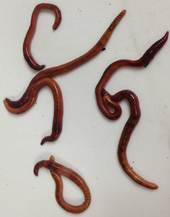Highlight
Earthworms accumulate cadmium from quantum dot nanoparticles
Achievement/Results
A team of researchers from the University at Buffalo has established that a newly commercialized nanomaterial is a source of the heavy metal cadmium when released in the soil environment. Dr. Diana S. Aga and her student, David T.R. Stewart, led the team conducting the research that was supported by the NSF programs Ecosystem Restoration through Interdisciplinary Exchange (ERIE) IGERT and the Major Research Instrumentation grant. In the study, earthworms grown in soil with a low concentration of cadmium selenide quantum dots accumulated much higher concentrations of cadmium in their tissue after only one week. Though the earthworms did not exhibit any obvious toxicity over the course of a four-week trial, there is a strong likelihood that the cadmium in the earthworms would be passed up the food chain.
Quantum dots are a type of nanoparticle first developed in the early 1990s but are now starting to be used in consumer products. A quantum dot is a semiconductor crystal made of only a few thousand atoms. This extreme smallness gives them a very special property; small changes in size can modified their color. Sony has recently begun selling a TV that uses quantum dots. Unfortunately, most of the elements that can used to make quantum dots are hazardous to human and environmental health. In addition, nanoparticles are suspected of being more dangerous due to their small size. This study found no evidence of harm at the very low concentration of cadmium added to the soil, but there is evidence that the cadmium bound up in quantum dots becomes more available to the earthworms over time.
Address Goals
Discovery: The use of quantum dots is expected to grow quickly in the coming years so understanding the danger of environmental exposure is becoming even more important. Further studies are ongoing to assess the stress earthworms experience in their metabolism when exposed to these low doses of quantum dots. This should provide a more sensitive measure of quantum dots harm to the environment.
Learning: The quantum dot project serves as the basis for the PhD dissertation of IGERT trainee David Stewart, who has also engaged in multiple activities to support K-12 science education, including the development of teaching modules related to his research in partnership with science teachers in the Buffalo Public School system.






